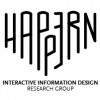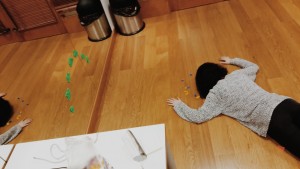Open offices are challenging work environments due to their distracting, social and immediate nature, and they are even more burdensome for those with cognitive impairments, particularly with autism. Over the last decade, companies from different fields such as software development (e.g. SAP, Microsoft) have started employing autistics after recognizing valuable work output that autistics create by their information processing skills, attention to detail, preferences in repetitive tasks and trustworthiness. However, their unique way of communicating and interacting with their surroundings, perceiving and processing information requires (1) special training for their coworkers, (2) modifying the work environment to make it more organized and less distracting and overwhelming, and (3) a tutor to moderate the social relations, the tasks and the idle time activities. These conventional solutions increase autistic employees’ work performance to some extent, yet they are not time- and cost-effective, are hard to integrate in different work environments and fall short to support natural social interaction between the coworkers, and the workflow. To overcome these fundamental issues where autistics work, here we present a novel concept, Mediated Reality Mirror (MRM), that enhances reciprocal interaction between autistic and non-autistic coworkers while fostering autistics’ work performance and work inclusion in open offices.
Autism spectrum disorder (ASD) is a wide range of neurodevelopmental conditions characterized by problems in communication and social interaction, sensory-perceptual atypicalities and repetitive and restricted behaviors. The manifestation degree of ASD varies from person to person and it is a lifelong condition which cannot be uprooted from the individual even with early intervention. The global prevalence of autism is estimated to be 62/10000 with an increasing trend, and with an unemployment estimation up to 75%, while the rest struggles sustaining a fulfilling employment due to numerous internal and external obstacles: Their condition requires tailor-cut vocational training and tutoring which are usually neglected by companies. Difficulties understanding directions, social cues, rules and roles, interacting with their coworkers hinder their performance and may result in job termination. Sensitivity to visual, social and auditory stimuli such as lighting, noise, movement, change, social interaction, as well as problems in executive functioning such as motor planning, sustained attention and acclimation to novelties and unexpectedness adversely affect successful task execution. Behavioral atypicalities such as tantrum and aggression may be misinterpreted or not well tolerated by their coworkers which results in high level of stress and anxiety while trying to socially fit in a non-autistic environment. Thus, implementing novel solutions in work environments to improve the abilities, experiences and potentials of autistics as well as their coworkers is a crucial task, which may also impact autistics’ vocational opportunities.
Standing at the intersection of human-computer interaction, interactive information visualization and cognitive psychology, MRM offers an assistive and adaptive work environment for supported and even competitive employment for individuals with ASD. MRM is a spatial and half-reflective natural interface which regulates the visually and socially challenging factors. It diminishes the distractions from the environment while augmenting social and task related visualizations, prompts and cues depending on the real-time sensory data (e.g. availability, emotional state, proximity between colleagues) primarily collected from the autistic employees and secondarily from their coworkers. The physical setup of MRM is highly affordable and consists of a wall (any wall in an open office), depth-sensors, a projector and a processor for real-time image manipulation. The preliminary prototype of MRM already functions in terms of user detection and basic image manipulation.
Given autism is a lifelong condition which can only be improved on the functional level, MRM pursues to serve as an assistive, but more importantly an adaptive platform which provides a common ground for individual differences, rather than taking them to a normative level. Taking this neurodiversity perspective, this project aims to make the following contributions: (a) exploring design patterns and user experience dimensions for adult autistics, who have been long neglected by HCI due to considerable orientation in early intervention technologies, and (b) using sensory data to inform the design process as well as to create a medium tailor-cut to individual.
Details:
Imagine yourself working at your desk in a crowded room sitting in front of a huge-sized mirror-like wall where you can see your own reflection and the people together with the space behind you. This wall is actually a projection display. It works with one depth-sense camera that captures the live scene of the room including your body and face. By means of a software, the captured image is transmitted to a projector which then projects it to the wall continuously so that you perceive the image as if it is a real reflection. Apart from reflecting the real time image to the wall, this display serves as a mediated reality system. It recognizes you and refines the image according to your social, emotional and perceptual needs in that crowded room.
Functions:
Diminishing the reality: Most of the movements, colors and forms you see around you, distract you. So, the display (that reflects the visual surrounding) erases specific components from the real time image and fills the erased area according to the properties of the surrounding area. The components that can be erased: People who are walking around // The person standing behind you // The person with a yellow t-shirt // An object with an organic form (in other words, no geometrical forms such as cubes, prisms, cylinders etc.) // Everything in the room apart from you
Modifying the reality: In some cases, even if they annoy you, you still need to see some of the distractions. So, the display modifies them in a way that they don’t annoy you anymore. In other words, it takes the annoyance out of these distractions. The possible modifications are that can be applied on the distractions are:
That person’s yellow t-shirt turns into another color (black, red, blue and green) // The giant close-up photo of a happy face on the side wall becomes abstract // Another painting with a checkered pattern on that wall becomes striped // Everything in the room apart from you becomes blurry or abstract
Regulating the proximity: Sometimes you don’t want any social interaction while working and sometimes you need some personal space to interact with people around you. So, the display helps you work by regulating the proximity between you and the people. These regulations are:
Showing your state of mind with abstract animations in a way that other people don’t come close to you or bother you // Animating how much personal space you need or how much they should get close to you

